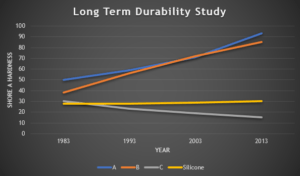Sealing the overlap on metal roof sheets – Addressing the feedback
When I released my original article regarding this well debated topic, I received a lot of great feedback from the industry.
Some of that feedback centred around the possibility of the sealant splitting due to the roof being trafficked either during installation or whilst the roof is being maintained. The argument being that if this happens, water would then be drawn into the split and trapped behind the sealant with no way of escaping, therefore magnifying the risk of reverse side corrosion.
The above scenario is a definite possibility and there are a couple of reasons that this could happen to a product;
- The strength and flexibility of the product was not up to the standard needed to cope with the movement of the roof sheet overlap for the duration of the product lifecycle meaning the product becomes brittle over time and splits when the roof is trafficked.
- The product was not installed to the specified thickness. This would result in a smaller bead of sealant and/or insufficient coating meaning the product would not have the strength needed to cope with the movement of the roof sheet overlap.
In response to the first point, we met with GE Silicones and Delvemade (now owned by Sharmans) who are the manufacturing partners behind the Seamsil system. They have been carrying out long term durability testing on their silicone products versus other chemistries such as silicone/polyurethane hybrids, one component polyurethanes and acrylics. The tests have been ongoing in Florida since 1983. Florida is used by many manufacturers to test their products due to its harsh climate with a general rule that each year in Florida is equivalent to two and a half years in the UK. To test the strength and flexibility of silicone vs the other chemistries, the products are applied between two surfaces, like the conditions we see on a metal roof and are checked periodically to measure the Shore A hardness using a durometer, this indicates whether the product has retained its flexible properties or become hard and brittle or soft and started to break down.
The products were last checked in 2013, 30 years after initial installation and the results speak for themselves:
- Where products A and B start relatively hard and over time become even harder and brittle, product C becomes softer, started to break down and experienced reversion.
- Only the pure silicone used in the Seamsil system retains its flexibility over this thirty-year period.

This leaves point number two. We are all aware of the saying “a product is only as good as the installer”. This is very true and is the main reason why Sharmans ensures that our products are only installed by our network of Approved Contractors in line with the NFRC’s drive to improve quality standards across the roofing industry. Sharmans network of Approved Contractors have all received comprehensive and rigorous training in our systems ensuring the highest level of application quality control.
Further to this, all installations covered by our guarantees are checked by our team of Technical Services Managers. This not only ensures that the correct amount of material is used, it also gives us the chance to ensure all the necessary preparation has been carried out.
To summarise, Sharmans confidently guarantees both the performance and application of the pure silicone Seamsil system when sealing the overlap.
In my next article I will be disputing suggestions that there is a right or wrong time to seal the overlap. If you wish to receive updates on future articles we post then don’t hesitate to get in touch either via our website, LinkedIn or call our sales team on 01298812371.
Author:
HD Sharman
